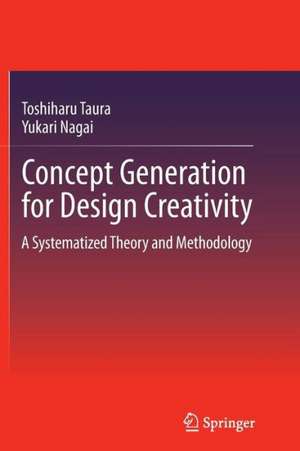Concept Generation for Design Creativity: A Systematized Theory and Methodology
Autor Toshiharu Taura, Yukari Nagaien Limba Engleză Paperback – 9 aug 2014
Concept Generation for Design Creativity – A Systematized Theory and Methodology presents the concept generation process both theoretically and methodologically. Theoretically, the concept generation process is discussed by comparing metaphor, abduction, and General Design Theory from the notions of similarities and dissimilarities. Analogy, blending, and integration by thematic relation have been explained methodologically. So far, these theories and methods have been discussed independently, and the relations among them have not been clarified. Two newly developed research methods to investigate the concept generation process are clearly explained: the explanation-based protocol analysis and constructive simulation.
By reading Concept Generation for Design Creativity – A Systematized Theory and Methodology, students, researchers and lecturers in design disciplines (including engineering design, industrial design, software design, CHI, design education, and cognitive science ) can obtain a clear picture of the advanced research findings and the outline of the theories and methods for concept generation. Furthermore, readers are expected to achieve the competence to generate new concepts.
| Toate formatele și edițiile | Preț | Express |
|---|---|---|
| Paperback (1) | 635.01 lei 6-8 săpt. | |
| SPRINGER LONDON – 9 aug 2014 | 635.01 lei 6-8 săpt. | |
| Hardback (1) | 640.06 lei 6-8 săpt. | |
| SPRINGER LONDON – 26 iul 2012 | 640.06 lei 6-8 săpt. |
Preț: 635.01 lei
Preț vechi: 747.06 lei
-15% Nou
Puncte Express: 953
Preț estimativ în valută:
121.51€ • 127.21$ • 100.54£
121.51€ • 127.21$ • 100.54£
Carte tipărită la comandă
Livrare economică 05-19 aprilie
Preluare comenzi: 021 569.72.76
Specificații
ISBN-13: 9781447158646
ISBN-10: 1447158644
Pagini: 184
Ilustrații: XII, 172 p.
Dimensiuni: 155 x 235 x 10 mm
Greutate: 0.27 kg
Ediția:2013
Editura: SPRINGER LONDON
Colecția Springer
Locul publicării:London, United Kingdom
ISBN-10: 1447158644
Pagini: 184
Ilustrații: XII, 172 p.
Dimensiuni: 155 x 235 x 10 mm
Greutate: 0.27 kg
Ediția:2013
Editura: SPRINGER LONDON
Colecția Springer
Locul publicării:London, United Kingdom
Public țintă
ResearchCuprins
What is Design and Creativity.- Design Insight for Concept Generation.- Theory for Concept Generation.- Role of Dissimilarity in Concept Synthesis for Concept Generation.- Thinking Pattern in Concept Synthesis.- Thinking Principle in Concept Synthesis.- Constraints for Concept Synthesis.- Design of Creative Motion: Application of Concept Blending (1).- Design of Creative Function: Application of Concept Blending(2).- Toward the Post Industrial Society.
Notă biografică
Toshiharu Taura is a vice-dean and professor in the Organization of Advanced Science and Technology (and professor in the Graduate School of Engineering) at Kobe University. He received his B.S., M.S., and Dr. Eng. degrees from the University of Tokyo, Japan, in 1977, 1979, and 1991, respectively. From 1979 until 1988, he worked as a mechanical engineer specialized in rolling mill at Nippon Steel Corporation. In 1992, he joined the University of Tokyo as an associate professor, and in 1998, he joined Kobe University as a professor in the Mechanical Engineering Department. He is currently working on several research themes that focus on the creative thought process of both engineering and industrial design, including interdisciplinary aspects of design science. He is a member of the Advisory Board, heads the Design Creativity SIG of the Design Society, and is a Fellow of the DRS (Design Research Society). He is also the recipient of the Best Paper Prize at the 2nd International Conference on Design Computing and Cognition (2006).
Yukari Nagai is a professor in the School of Knowledge Science at Japan Advanced Institute of Science and Technology. She graduated from Musashino Art University, majored in Design (M.A.), and conducted research abroad at the Creativity and Cognition Research Studios, Loughborough University (2002). She received Ph.D.s from Chiba University (2003) and the University of Technology, Sydney (2009). She was also awarded the Best Paper Prize at DESIGN2002 Conference and International Conference on Design Computing and Cognition (2006). She is a member of the Advisory Board and co-chair of SIG Design Creativity of the Design Society, and is a Fellow of the DRS. She has served as an editorial board member of the Journal of Engineering Design and contributed as guest editor to the special issue of the journal “Artifact” (2008). Her research interests are design creativity, design knowledge, and creativecognition.
Yukari Nagai is a professor in the School of Knowledge Science at Japan Advanced Institute of Science and Technology. She graduated from Musashino Art University, majored in Design (M.A.), and conducted research abroad at the Creativity and Cognition Research Studios, Loughborough University (2002). She received Ph.D.s from Chiba University (2003) and the University of Technology, Sydney (2009). She was also awarded the Best Paper Prize at DESIGN2002 Conference and International Conference on Design Computing and Cognition (2006). She is a member of the Advisory Board and co-chair of SIG Design Creativity of the Design Society, and is a Fellow of the DRS. She has served as an editorial board member of the Journal of Engineering Design and contributed as guest editor to the special issue of the journal “Artifact” (2008). Her research interests are design creativity, design knowledge, and creativecognition.
Textul de pe ultima copertă
The concept generation process seems like an intuitional thought: difficult to capture and perform, although everyone is capable of it. It is not an analytical process but a synthetic process which has yet to be clarified. Furthermore, new research methods for investigating the concept generation process—a very difficult task since the concept generation process is driven by inner feelings deeply etched in the mind—are necessary to establish its theory and methodology.
Concept Generation for Design Creativity—A Systematized Theory and Methodology presents the concept generation process both theoretically and methodologically. Theoretically, the concept generation process is discussed by comparing metaphor, abduction, and General Design Theory from the perspective of similarities and dissimilarities. Property mapping, concept blending, and concept integration in thematic relation have been explained methodologically. So far, these theories and methods have been discussed independently, and the relations among them have not been clarified. Two newly developed research methods to investigate the concept generation process are clearly explained: extended protocol analysis and constructive simulation.
By reading Concept Generation for Design Creativity—A Systematized Theory and Methodology, students, researchers and lecturers in design disciplines (including engineering design, industrial design, software design, CHI, design education, and cognitive science) can obtain a clear picture of the advanced research findings and the outline of the theories and methods for concept generation. Furthermore, readers are expected toachieve the competence to generate new concepts.
Concept Generation for Design Creativity—A Systematized Theory and Methodology presents the concept generation process both theoretically and methodologically. Theoretically, the concept generation process is discussed by comparing metaphor, abduction, and General Design Theory from the perspective of similarities and dissimilarities. Property mapping, concept blending, and concept integration in thematic relation have been explained methodologically. So far, these theories and methods have been discussed independently, and the relations among them have not been clarified. Two newly developed research methods to investigate the concept generation process are clearly explained: extended protocol analysis and constructive simulation.
By reading Concept Generation for Design Creativity—A Systematized Theory and Methodology, students, researchers and lecturers in design disciplines (including engineering design, industrial design, software design, CHI, design education, and cognitive science) can obtain a clear picture of the advanced research findings and the outline of the theories and methods for concept generation. Furthermore, readers are expected toachieve the competence to generate new concepts.
Caracteristici
Outlines the theories and methods of concept generation Enables readers to generate new concepts Includes two new approaches to the concept generation process Includes supplementary material: sn.pub/extras












